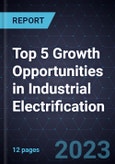Multi-stakeholder Collaboration and Technological Innovations to Boost Electrification of Industrial Segments
Geopolitical crises, such as the Russo-Ukrainian War and the recent Israeli-Hamas War, have highlighted the risks and challenges associated with dependency on imported fossil fuels. Energy security has become an important global megatrend since 2022, driving significant investment in renewable generation and other low-carbon alternatives. However, specific progress in the decarbonization of the industrial sector has lagged considerably. This is significant as the industrial sector accounted for approximately 29% of total emissions in 2022, a rate that has been relatively stable for the past decade.
Despite the fuel cost fluctuations, industrial companies have preferred to stick with fossil fuels for numerous reasons. To begin, the high upfront capital cost of replacing existing fossil-fuel-based infrastructure is a challenge, particularly in the current climate in which these costs are even higher. High electricity prices reduce the rate-of-return. Policy support and incentives are lacking, and policymakers have had other priorities. All these considerations make it easier for businesses to ‘sweat assets’ and delay investment.
Things are starting to change. After two years of cost inflation across all industries, cost inflation pressures are starting to ease, and technology costs for electrification solutions should drop faster than the inflationary average. New solutions are gradually entering the market. Companies that need to make investments are increasingly concerned about purchasing a fossil asset that could be heavily regulated in 5 years.
Table of Contents
Strategic Imperatives
Top 5 Growth Opportunities
- Growth Opportunity 1: Efficient Heating Technologies
- Growth Opportunity 2: Integration with Automation & IIoT
- Growth Opportunity 3: Growth of Virtual Power Plant (VPP)/Demand Response (DR)
- Growth Opportunity 4: Electrification of Oil & Gas
- Growth Opportunity 5: Electrification of High-temperature Industrial Processes
Next Steps








